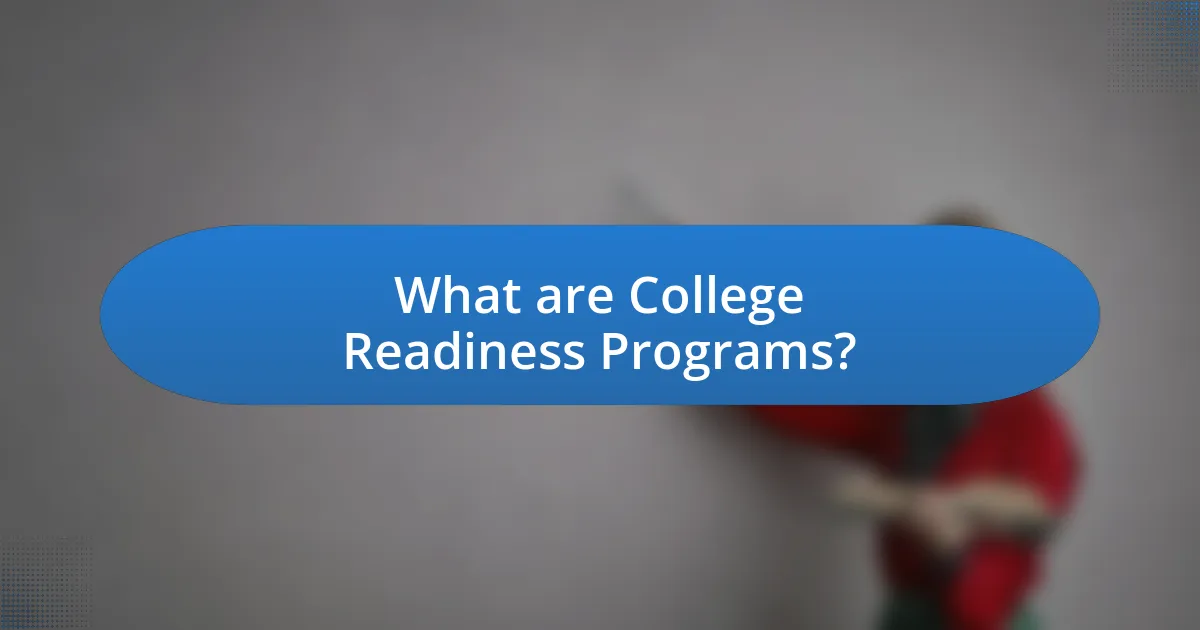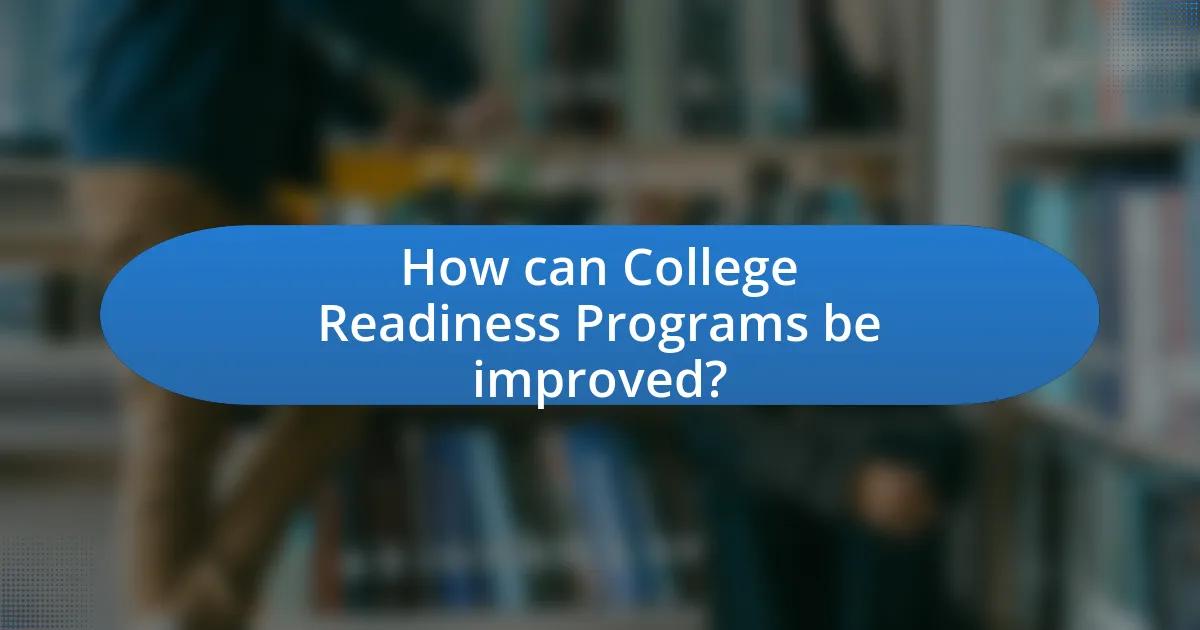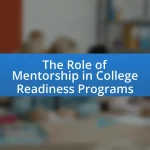College readiness programs are structured initiatives aimed at preparing high school students for the academic and social challenges of higher education. These programs focus on enhancing essential skills such as critical thinking, time management, and study habits, while also providing guidance on college applications and financial aid. Research shows that participation in these programs significantly increases college enrollment and persistence rates among students. The article explores the key components, goals, and success stories of college readiness programs, highlighting their impact on student perspectives and outcomes, as well as the importance of ongoing support and community partnerships in fostering educational success.

What are College Readiness Programs?
College readiness programs are structured initiatives designed to prepare high school students for the academic and social demands of college. These programs typically focus on enhancing essential skills such as critical thinking, time management, and study habits, while also providing guidance on college applications and financial aid processes. Research indicates that students who participate in college readiness programs are more likely to enroll in postsecondary education and persist through their studies, demonstrating the effectiveness of these programs in bridging the gap between high school and college success.
How do College Readiness Programs function?
College readiness programs function by providing students with the necessary skills, resources, and support to successfully transition from high school to college. These programs typically include academic tutoring, college counseling, and workshops focused on study skills, time management, and financial literacy. Research indicates that students who participate in such programs are more likely to enroll in college and persist through their studies, as evidenced by a study from the National Center for Education Statistics, which found that participants in college readiness initiatives had higher college enrollment rates compared to their peers.
What key components are involved in College Readiness Programs?
Key components involved in College Readiness Programs include academic preparation, counseling services, and skill development. Academic preparation focuses on enhancing students’ knowledge in core subjects such as math, reading, and writing, ensuring they meet college admission standards. Counseling services provide guidance on college selection, application processes, and financial aid options, helping students navigate their educational paths. Skill development encompasses critical thinking, time management, and study skills, equipping students with the tools necessary for success in higher education. These components collectively aim to bridge the gap between high school and college, fostering a smoother transition and increasing the likelihood of college success.
How do these components contribute to student success?
College readiness programs contribute to student success by equipping students with essential academic skills, emotional support, and practical resources necessary for higher education. These programs enhance students’ understanding of college expectations, improve their study habits, and foster resilience, which are critical for navigating the challenges of college life. Research indicates that students who participate in college readiness programs are more likely to enroll in post-secondary education and persist through their studies, as evidenced by a study from the National Center for Education Statistics showing that participants have higher graduation rates compared to non-participants.
What are the goals of College Readiness Programs?
The goals of College Readiness Programs are to equip students with the necessary skills, knowledge, and resources to successfully transition to post-secondary education. These programs aim to enhance academic preparedness, improve study habits, and foster essential life skills such as time management and critical thinking. Research indicates that students who participate in such programs are more likely to enroll in college and persist through their studies, as evidenced by a study from the National Center for Education Statistics, which found that students involved in college readiness initiatives had higher college enrollment rates compared to their peers.
How do these goals align with student needs?
The goals of college readiness programs align with student needs by addressing the specific skills and knowledge required for academic success in higher education. These programs focus on enhancing critical thinking, time management, and study skills, which are essential for navigating college coursework effectively. Research indicates that students who participate in college readiness initiatives demonstrate improved academic performance and higher enrollment rates in post-secondary institutions, as evidenced by a study from the National Center for Education Statistics showing that 90% of participants felt more prepared for college-level work. This alignment ensures that students are equipped to meet the challenges of higher education, ultimately leading to better educational outcomes.
What metrics are used to measure the success of these programs?
Metrics used to measure the success of college readiness programs include graduation rates, college enrollment rates, standardized test scores, and student retention rates. Graduation rates indicate the percentage of students who complete the program, while college enrollment rates reflect the number of participants who proceed to higher education. Standardized test scores assess academic preparedness, and student retention rates measure the ability of programs to keep students engaged and enrolled. These metrics provide concrete evidence of the effectiveness of college readiness initiatives in facilitating student transitions to post-secondary education.

What impact do College Readiness Programs have on students?
College Readiness Programs significantly enhance students’ preparedness for higher education. These programs provide essential skills, resources, and support that improve academic performance and increase college enrollment rates. For instance, research conducted by the National Center for Education Statistics indicates that students who participate in such programs are 20% more likely to enroll in college compared to their peers who do not. Additionally, these programs often include mentorship and guidance, which help students navigate the college application process, further contributing to their success in higher education.
How do these programs change students’ perspectives on college?
College readiness programs significantly alter students’ perspectives on college by providing them with essential skills, knowledge, and confidence needed for higher education. These programs often include academic support, mentorship, and exposure to college environments, which help demystify the college experience. Research indicates that participants in such programs report increased motivation and a clearer understanding of the college application process, leading to higher enrollment rates. For instance, a study by the College Board found that students involved in college readiness initiatives were 20% more likely to apply to college compared to their peers who did not participate. This evidence demonstrates that these programs effectively reshape students’ views, making college more accessible and achievable.
What specific skills do students gain from participation?
Students gain critical thinking, teamwork, communication, and problem-solving skills from participation in college readiness programs. These programs often involve collaborative projects, discussions, and presentations that require students to analyze information, work effectively with peers, articulate their ideas clearly, and develop solutions to complex challenges. Research indicates that students who engage in such programs demonstrate improved academic performance and greater preparedness for college-level coursework, as evidenced by studies showing a correlation between participation in readiness programs and higher college retention rates.
How do these skills translate to academic success in college?
Skills acquired through college readiness programs translate to academic success in college by enhancing students’ preparedness for the rigors of higher education. These programs often focus on critical thinking, time management, and effective communication, which are essential for navigating college coursework. Research indicates that students who participate in such programs demonstrate higher retention rates and improved GPA outcomes compared to their peers who do not engage in these preparatory activities. For instance, a study by the National Center for Education Statistics found that students involved in college readiness initiatives were 20% more likely to persist in their studies through to graduation. This evidence underscores the direct correlation between the skills developed in readiness programs and the academic achievements attained in college.
What are some success stories from College Readiness Programs?
College readiness programs have significantly impacted students’ academic trajectories, with numerous success stories highlighting their effectiveness. For instance, the College Bound program in Washington, D.C., has helped over 1,000 low-income students gain admission to college since its inception in 2001, with 90% of participants enrolling in post-secondary education. Another example is the Upward Bound program, which has consistently shown that participants are 20% more likely to enroll in college compared to their peers who did not participate. These programs provide essential resources, mentorship, and academic support, leading to increased college enrollment and success rates among underrepresented populations.
Who are notable individuals that have benefited from these programs?
Notable individuals who have benefited from college readiness programs include Michelle Obama, who participated in the Upward Bound program, which helped her gain access to higher education. Additionally, former U.S. Secretary of Education Arne Duncan credits his success to the support he received from similar initiatives during his youth. These examples illustrate how such programs can significantly impact individuals’ educational trajectories and opportunities for success.
What challenges did these individuals overcome through the programs?
Individuals in college readiness programs overcame challenges such as academic underperformance, lack of access to resources, and low self-confidence. These programs provided targeted support, including tutoring, mentorship, and workshops, which helped improve their academic skills and foster a belief in their potential. For instance, participants often reported significant improvements in their grades and standardized test scores, demonstrating the effectiveness of the programs in addressing educational gaps and enhancing their readiness for college.

How can College Readiness Programs be improved?
College readiness programs can be improved by integrating personalized academic support and mentorship. Research indicates that tailored interventions, such as one-on-one tutoring and mentoring, significantly enhance student engagement and success rates. For instance, a study by the National Center for Education Statistics found that students who participated in personalized support programs were 20% more likely to enroll in college compared to their peers without such support. Additionally, incorporating real-world experiences, such as internships and college visits, can provide students with practical insights into college life, further preparing them for the transition.
What feedback do participants provide about their experiences?
Participants provide overwhelmingly positive feedback about their experiences in college readiness programs, highlighting increased confidence and improved academic skills. Many participants report feeling more prepared for college-level coursework and better equipped to navigate the college application process. For instance, a survey conducted by the National College Access Network found that 85% of students who participated in such programs felt more confident in their ability to succeed in college. Additionally, testimonials from participants often emphasize the supportive environment and mentorship received, which they attribute to their enhanced motivation and goal-setting abilities.
How can program structures be adapted to better serve diverse populations?
Program structures can be adapted to better serve diverse populations by incorporating culturally relevant curricula, flexible scheduling, and targeted support services. Culturally relevant curricula ensure that educational content reflects the backgrounds and experiences of diverse students, which has been shown to enhance engagement and learning outcomes. Flexible scheduling accommodates the varying availability of students, particularly those balancing work or family responsibilities, thereby increasing participation rates. Targeted support services, such as mentorship programs and language assistance, address specific barriers faced by underrepresented groups, leading to improved retention and success in college readiness programs. Research indicates that programs employing these strategies have significantly increased enrollment and graduation rates among diverse populations, demonstrating their effectiveness in fostering educational equity.
What innovative practices can enhance the effectiveness of these programs?
Innovative practices that can enhance the effectiveness of college readiness programs include personalized learning plans, mentorship initiatives, and the integration of technology. Personalized learning plans allow students to receive tailored educational experiences that address their unique strengths and weaknesses, leading to improved engagement and outcomes. Mentorship initiatives connect students with experienced professionals who provide guidance, support, and encouragement, which has been shown to increase college enrollment rates. The integration of technology, such as online resources and interactive platforms, facilitates access to information and learning tools, making education more accessible and engaging. Research indicates that programs incorporating these practices have seen significant improvements in student performance and college readiness, demonstrating their effectiveness in transforming educational experiences.
What best practices should be followed in implementing College Readiness Programs?
Best practices for implementing College Readiness Programs include establishing clear goals, providing comprehensive support services, and fostering partnerships with local colleges. Clear goals ensure that the program aligns with student needs and institutional objectives, while comprehensive support services, such as tutoring and counseling, address academic and emotional challenges faced by students. Partnerships with local colleges facilitate resource sharing and create pathways for students to transition smoothly into higher education. Research indicates that programs with these elements significantly improve student outcomes, as evidenced by a study from the National Center for Education Statistics, which found that students participating in structured readiness programs were 20% more likely to enroll in college compared to their peers.
How can community partnerships strengthen these programs?
Community partnerships can strengthen college readiness programs by providing essential resources, expertise, and support networks that enhance program effectiveness. These partnerships often involve local businesses, educational institutions, and non-profit organizations that contribute funding, mentorship, and real-world experiences, which are crucial for student engagement and success. For instance, a study by the National Center for Education Statistics found that students participating in programs with community partnerships had a 20% higher college enrollment rate compared to those without such support. This demonstrates that collaborative efforts can significantly improve educational outcomes and better prepare students for higher education.
What role does ongoing support play in student success post-program?
Ongoing support plays a crucial role in student success post-program by providing continuous guidance and resources that enhance learning and adaptation to new environments. This support helps students navigate challenges, maintain motivation, and apply skills learned during their programs effectively. Research indicates that students who receive ongoing support are 30% more likely to persist in their educational pursuits and achieve their academic goals, as they benefit from mentorship, networking opportunities, and access to resources that facilitate their transition into higher education or the workforce.

